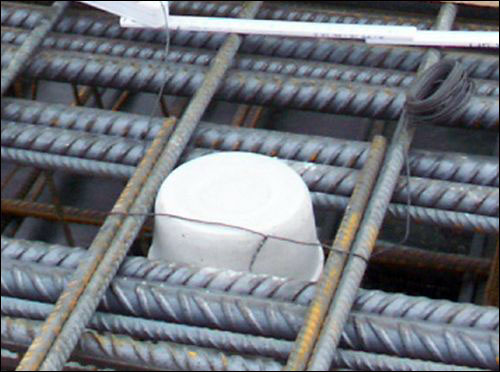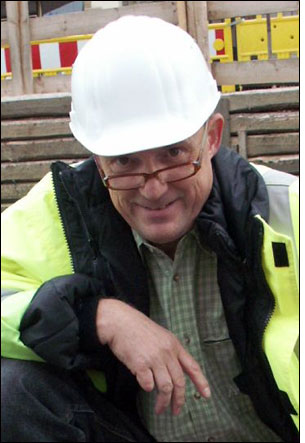Oct 10, 2012Last month, the German city of Boppard completed the construction of a parking garage in which RFID-based sensors are embedded in the building's cement, in order to detect moisture and corrosion that can result in structural damage.
The passive tags with sensors—which were placed below the cement's surface and above reinforcement steel at select spots throughout the parking garage—can be read via a handheld device to detect the onset of corrosion or excessive moisture. This enables the city to repair the problem before it can harm the actual reinforcement steel.

When steel in a building's supports becomes corroded, repairs can be extremely expensive, says Wolfgang Hill, the head of product development and technology at Selfsan Consult GmbH, an engineering consulting company in Boppard that co-developed the system. When repairs can be made before corrosion reaches that stage, he adds, the cost is only a fraction of that amount.
The so-called "CorroDec" corrosion-monitoring system was developed in cooperation with BS2 Sicherheitssysteme GmbH, in Boppard, which manufactures security and construction-monitoring solutions. The system detects corrosion in the event that a wire connected to the corrosion sensor becomes rusted, Hill explains, thereby causing a break in the electrical circuit. It can also detect corrosion if the reading distance begins to shorten, he adds.
The city of Boppard decided to install the sensors within its new parking garage, located near the city hall, in order to keep maintenance costs down over the long term. At other garages the city maintains, it has been faced with damaged cement, often due to salt in the melting snow and ice brought into the garages on the tires and undersides of vehicles that park there during winter.
The project is one of several for which Selfsan Consult has supplied the corrosion-sensing RFID system, manufactured by BS2. For instance, Hill says, some 150 sensors are embedded within the pavement at Frankfurt Airport, near a landing strip, to provide airport operators with an early warning of pavement corrosion that could prove dangerous for aircraft.
For the parking garage in Boppard, Selfsan Consult worked with the building's architects to define areas where 16 RFID corrosion sensor tags should best be placed. The city did not have a large budget for placing more than 16 corrosion sensors in the garage, so the architects chose to embed the sensors near the parking spots closest to the building's entrance, since these spots are used most often.
The tags are embedded near supports close to the drains that receive the most salty runoff water. The application utilizes a handheld reader provided by AEG ID that Selfsan Consult and BS2 modified, along with specially modified 125 kHz passive low-frequency (LF) RFID tags compatible with EM Microelectronic's RM 4100 air-interface protocol.
The three-story parking garage has a roof level on which greenery has been planted. The architects opted to place 15 RFID-enabled moisture-monitoring sensors near the roof's drainage system. If the drainage system were to fail, water could collect in unanticipated places and, if it then froze, potentially damage the cement.
"Cement can be unpredictable," Hill states.
The moisture-sensing passive RFID tags are similar to the corrosion sensors, except that the tags are not attached to corrosion-detecting metal wires. Instead, two rings of stainless steel, attached around the sensors, determine the presence of moisture when the electrical resistance between the rings changes.
The parking garage in Boppard is using the first generation of the corrosion-monitoring system developed by Selfsan Consult. In the meantime, the firm is working with the Fraunhofer Institute for Microelectronic Circuits and Systems, in Duisburg, to create a second generation of tags that will employ a special chip operating at 134 kHz. Fraunhofer is providing Selfsan Consult with an amplifier that will extend the reading range so that the embedded tags can be read remotely and automatically via a wireless local area network (WLAN), Hill says, adding that he expects the technology to become available next year.
"When we develop monitoring tools for the construction industry, we've got to keep all the complexities of construction in mind," Hill says, "making sure all the parts can work together and that the system as a whole will stand the test of time."
Hill describes his monitoring system as easy to operate, since there are no measurements that need to be interpreted. When tags are interrogated, the garage operators receive a simple yes/no answer—indicating whether corrosion or moisture is present.
According to Hill, the city of Boppard spent €8,000 ($10,300) on the monitoring system, as part of a total construction cost of roughly €5 million $6.4 million). The city expects significant savings on maintenance costs over the parking garage's lifetime, he reports.


